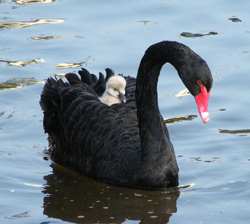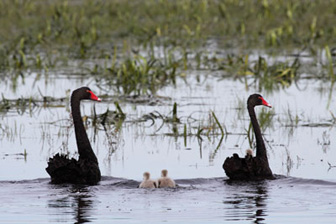Tom Parkinson's monthly column, introducing the diverse range of flora and fauna on show at Sanctuary Lakes.
Black swans are endemic to Australia, breeding primarily on wetlands in south-eastern and western Australia. Sanctuary Lakes is a perfect black swan neighbourhood where they can be seen constantly foraging their favourite algae and submerged weeds, by "pending" tipping forward and reaching with their long necks down below the surface, their bottoms up and their legs comically waggling in the air. Black swans have long intrigued us with their seemingly romantic relationships and quirky behaviours.
The outside world refused to believe in their existence when the first black swans were seen by Europeans in 1691, and were only convinced once Willem de Vlamingh's managed to dispatch a couple of specimens back to Europe in 1697. The Europeans have never quite got over the fact that the imperial white swan had a surprise black equivalent. 50 years ago the famous mathematician philosopher Dr Karl Popper stated "all swans are white is testable by being falsifiable". He then filled half a black board with a mathematical equation proving the point. Even in this decade, economist Nicholas Taleb book the "Theory of Black Swan Events" is a metaphor that describes events that come as a surprises, have a major effect, and are often inappropriately rationalized after the fact with the benefit of hindsight.
On the practical side, the University of Melbourne's study of around 250 black swans at Albert Park Lake over the past ten years has allowed a team of researchers, led by Associate Professor Raoul Mulder from the Department of Zoology, to unearth fascinating aspects of swan behaviour.
Such discoveries include the debunking of the notion that black swans are monogamous. The research revealed that although swans tend to form long term pair bonds, infidelity is rife, with around one in six cygnets being the product of an illicit encounter.
Other studies have shown that around a third of all broods exhibit extra-pair paternity. An estimated one-quarter of all pairings are homosexual, mostly between males. They steal nests, or form temporary threesomes with females to obtain eggs, driving away the female after she lays the eggs.
After hatching, the cygnets are tended by the parents for about 9 months until fledging.
One aspect of black swan behaviour which remains poorly understood is their movement patterns around SE Australia. Black swans are nomadic and travel vast distances, but we don't know why and where they move.
In the hope of finding factual information on their nomadic behaviour the Albert Park research group came up with a solution; an interactive website - mySwan.org.au - that allows members of the public to report sightings of tagged black swans and in return receive information on the history of "their" swan.
As you will have noticed many of the swans around Sanctuary Lakes have Albert Park's distinctive tag around the base of their necks. To help the research just note the number and email it to mySwan.org.au. I did this last month and they informed me that my swan had flown in from Ballarat and had previously been spotted in Barwon.
Breeding starts around August and will continue until mid-November. Nesting tends to be in the reeds around the ponds. The clutch contains between 4 and 11 eggs which are pale green-white in colour, and laid at intervals of 1-2 days. Incubation typically commences only when the clutch has been completed, and lasts for 35-40 days. We should be viewing the first vintage of 2014 cygnets by mid to late September.
Once the cygnets are ready to feed from the Lake, the swans will carry them on their backs from the nest to the main lake. Last season I watched this wonderful family moment from the pier by the security office. The adult swan walked down the boat ramp and on its back gently secured by its wings were six tiny excited feathery cygnets.
Our neighbours are truly special!

